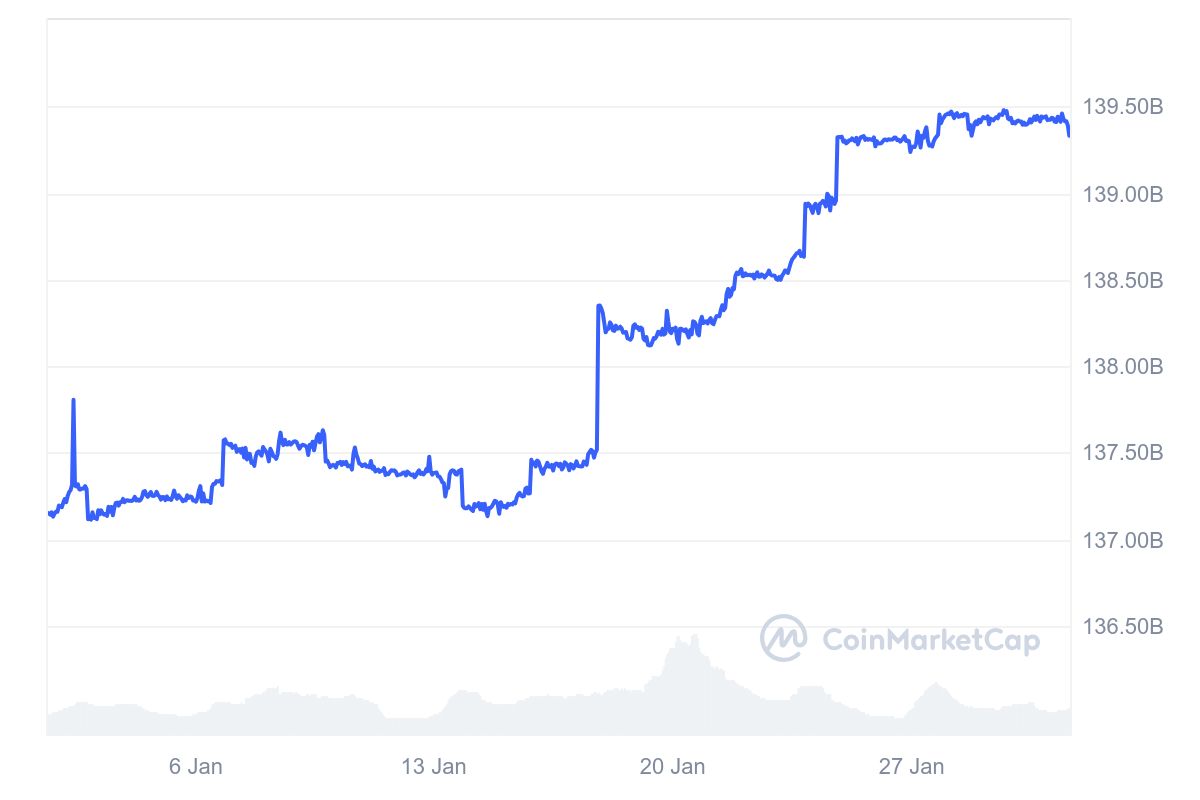Tether Posts $13B Profit in 2024, Bolsters Reserves with $113B U.S. Treasury Backing
- Tether’s 2024 net profit hit $13B, group equity surpassed $20B, and reserves buffer reached a record $7B.
- USD₮ issuance grew $45B in 2024, backed by $113B U.S. Treasury holdings reinforcing stablecoin dominance.
Tether Holdings Limited reported a net profit of $13 billion for 2024, with total equity exceeding $20 billion. The stablecoin issuer’s reserve buffer reached $7 billion, its highest since inception, as confirmed by auditor BDO.
Total assets rose to $157.6 billion against liabilities of $137.6 billion, reflecting a liquidity-first approach. These gains follow strategic allocations to Bitcoin mining, AI infrastructure, and renewable energy projects.
The company now holds $113 billion in U.S. Treasury bonds, ranking among the top global holders of U.S. sovereign debt. This positions USD₮, Tether’s dollar-pegged stablecoin, as one of the most collateralized digital assets.
 Source: Coinmarketcap
Source: Coinmarketcap
USD₮ circulation expanded by $45 billion in 2024, including $23 billion in Q4 alone, cementing its 68% market share. Demand surged as traders sought stability during crypto volatility, with Tether generating $87.2 million in weekly fees from transactions.
Regulatory compliance efforts included securing a Digital Asset Service Provider license in El Salvador, where Tether relocated its headquarters.
Concurrently, Tether integrated USD₮ with Bitcoin’s Lightning Network, enabling sub-cent transaction fees and near-instant settlements. This technical upgrade leverages Bitcoin’s base-layer security while bypassing its historical throughput constraints.
Tether’s reserve composition remains dominated by cash equivalents (85%), primarily U.S. Treasuries, with 4% allocated to Bitcoin. The firm plans to allocate 15% of quarterly profits to BTC purchases, reinforcing its treasury diversification strategy.
Critics highlight concentration risks in U.S. debt exposure, but Tether asserts its reserves exceed redemption demands by $7 billion.
The Lightning Network integration allows users to transact USD₮ via Bitcoin’s layer-2 channels without intermediaries, as reported by ETHNews. Merchants in El Salvador already pilot USD₮ payments for goods, sidestepping traditional banking rails. Developers note this could reduce reliance on Ethereum-based stablecoins for micropayments, though adoption requires wallet upgrades.
ETHNews market analysts attribute Tether’s profitability to interest income from Treasuries, which yielded ~4.5% annually. USD₮’s growth correlates with declining stablecoin competition, as Circle’s USDC circulation plateaued at $28 billion.
Tether’s dominance now extends beyond crypto trading into remittance corridors, with $1.2 billion daily volume across emerging markets.
Disclaimer: The content of this article solely reflects the author's opinion and does not represent the platform in any capacity. This article is not intended to serve as a reference for making investment decisions.
You may also like
Cardano Foundation’s 2024 Report Highlights: Enterprise Growth, Education, and Governance Focus

How Tyler Spalding Built Flexa for Crypto Transactions

El Salvador Accelerates Bitcoin Purchases Despite IMF Agreement

🚨 TeddyPuff ($TDP) Presale Countdown: Secure Your Spot Before Prices Rise!

